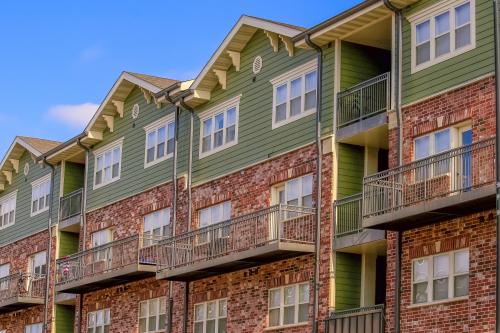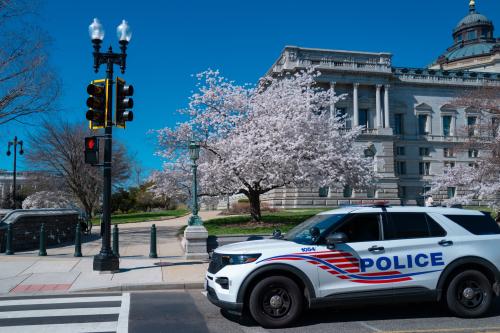In case you missed it, watch the webinar held on May 19, 2021 that discussed the key findings from the full report.
While the long-term economic impacts of the COVID-19 pandemic are still uncertain, the sharp increase in remote work has raised some fundamental questions about the geography of jobs and the demand for both housing and commercial real estate.
If professional workers who drive the demand for premium-location office space remain working from home, it could have profound impacts on downtown business districts. Dense clusters of office jobs have traditionally brought in customers for nearby businesses like coffee shops, restaurants, and dry cleaners. If remote work (or a hybrid model) persists, it could have ripple effects throughout regional labor markets and commercial real estate, as well as altering where workers choose to live.
In our new report, we examine the geography of jobs in the Washington, D.C. region prior to COVID-19, with an eye toward understanding how the pandemic could change employment and commercial real estate throughout the region. Below, we highlight a few of our key findings.
» Download the State of the Capital Region: Where Capital Region workers live and labor report
Downtown Washington, D.C. had the largest concentration of jobs prior to COVID-19
The capital region’s jobs were highly concentrated near its central business district (CBD), which we approximate as the area within 5 kilometers of the White House. This area encompasses most of central Washington, D.C. and some close-in parts of Arlington, Va., including Rosslyn and the Pentagon. The inner core had an employment density of more than 9,000 jobs per square kilometer (Figure 1)—more than four times the density of further-flung neighborhoods. The District is home to 20% of the region’s jobs, but only 10% of the region’s workforce.

Downtown Washington, D.C. offers location advantages to both employers and workers. The region’s hub-and-spoke rail system was designed to channel commuters from suburban residential areas into the CBD. Because downtown is roughly in the geographic center of the region, it is reasonably accessible from all directions. Job-rich areas attract still more jobs, offering new firms access to existing businesses, customers, and amenities.
Offsetting these employment centralization and density advantages is the fact that downtown office and retail rents are higher than in other parts of the region. Similarly, streets, sidewalks, and public transit can become congested, especially during peak commuting times.
The capital region has several large suburban job clusters outside downtown, which track closely to major highways. The largest suburban job centers include Tysons Corner and Reston in Fairfax, Va., and the northwest corridor along I-270 in Montgomery County, Md., between Bethesda and Gaithersburg.
White-collar industries drive the capital region’s economy
Although the Washington, D.C. region is famous as the seat of the federal government, the government is not the region’s largest industry. Rather, the largest share of workers is employed in professional and business services, a category that includes law, finance, consulting, and a variety of other fields. (Notably, this also includes companies that contract for government agencies.)
The capital region employs more workers in both professional services and government than the U.S. as a whole (shown by the red lines in Figure 2). These industries tend to employ more college-educated workers, pay relatively high salaries, and—salient during the past year—can more easily be performed remotely.

Not all parts of the region have a similar employment mix. Figure 3 shows the industry composition for three large job clusters: Farragut North in downtown Washington, D.C.; Tysons Corner, Va.; and Rockville, Md.
Farragut North has roughly equal numbers of workers in the region’s two dominant industries (professional services and government), but also a substantial number of jobs in leisure and hospitality. The area includes many restaurants, bars, coffee shops, and hotels, which serve office workers, tourists, and business travelers. Rockville has the most balanced industry mix, while Tysons Corner is the most specialized, with a clear dominance of professional services and very few government jobs. Industry mix has implications for commercial real estate demand, especially if remote work continues as a longer-term trend.

COVID-19 has decimated leisure and hospitality jobs
The COVID-19 pandemic caused job losses in all sectors of the capital region’s economy, but these losses were not equally distributed. The leisure and hospitality industry—which previously formed about 10% of the region’s employment—saw the largest job losses, reflecting both new regulations and consumer preferences. State and local public health agencies placed restrictions on restaurants and bars, while risk-averse consumers have avoided congregating in shared indoor spaces like movie theaters.
During the first few months of the pandemic, leisure and hospitality jobs fell to nearly half of their January 2020 levels. By the end of 2020, jobs had recovered somewhat, but were still well below pre-pandemic levels. A key question for economic recovery is when enough consumers will resume in-person gatherings—which will likely correlate with more widespread rollout of vaccines and subsequent updates to public health guidelines.

Low-wage workers live farther from job clusters
Job losses during the pandemic have hit low-wage workers the hardest, especially those employed in service sectors that cannot be performed remotely (e.g., food service). Low-wage workers were already at a disadvantage in housing markets because they cannot compete with higher-income households for desirable locations. Neighborhoods close to major job centers and with good public transportation tend to have more expensive housing—pushing many low-income workers to seek cheaper rents in inconvenient locations.
Figure 5 shows that low-wage workers (those earning less than $3,333 per month) are more concentrated on the eastern side of the District, the inner ring of Prince George’s County, Md., and the farther western exurbs. Commuting from these areas to dense job clusters such as Farragut North, Tysons Corner, and Rockville requires more time and money from workers. Proposed cuts to public transportation will create the most hardship for workers who cannot afford to own cars and those who work irregular or off-peak hours, when transit service is less frequent.

Our work habits will affect the future of cities, neighborhoods, and workers
The past year has brought enormous uncertainty to workers, businesses, and policymakers about the future of work. Will highly educated professionals revolt if asked to return to daily commutes and rigid schedules? Can employers save money by reducing their office space and related expenses such as insurance, utilities, and supplies? Should local governments alter land use planning to accommodate “15-minute cities” that incorporate more commercial space in residential areas? Are downtowns as we know them finished? Will people flee urban areas altogether for more space in far-flung rural areas—or are people itching to return to face-to-face contact?
While it’s still too early to have much data on people’s long-term preferences, our research suggests three areas to watch.
First, in-person industries such as leisure and hospitality will take time to recover. Continuing uncertainty over when enough people will have been vaccinated to reach herd immunity makes it difficult to predict when consumers will want to fully re-engage with previous activities. And some workers in this sector may have moved on, geographically or into different jobs.
Second, don’t count downtowns out yet. The fundamental reason that draws businesses to CBDs and large employment subcenters still exists: Firms and workers are more productive when they locate close together, especially in “knowledge industries.” It’s hard to imagine congressional representatives and lobbyists choosing to hobnob indefinitely over Zoom instead of resuming in-person power lunches.
Third, cultural institutions and amenities will still attract residents and tourists to the capital region. Even if a substantial share of highly educated professionals adopts a hybrid telework/in-office schedule, people will still want places to socialize and recreate outside their homes. Attractively maintained outdoor spaces such as the District’s waterfront parks and the C&O Canal trail have been enormously popular during the pandemic. The Smithsonian museums aren’t likely to move off the National Mall anytime soon. Local governments that want to retain residents who may have wider job options would do well to continue investing in high-quality public services and amenities that improve daily quality of life.
The Brookings Institution is committed to quality, independence, and impact.
We are supported by a diverse array of funders. In line with our values and policies, each Brookings publication represents the sole views of its author(s).











Commentary
What pre-pandemic job trends suggest about the post-pandemic future of the capital region
May 12, 2021